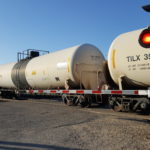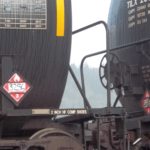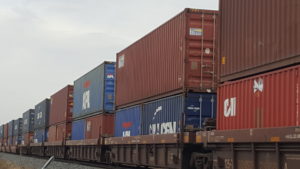In the general placarding requirements of 49 CFR 172.504(a) of the USDOT/PHMSA Hazardous Materials Regulations (HMR), it states that when required each bulk packaging, freight container, unit load device, transport vehicle, or rail car “must be placarded on each side and each end”. Simple enough, right?
It becomes more complicated when we consider the visibility and display of those placards on a motor vehicle or rail car.
The purpose of this article is to address solely the requirements of the HMR at §172.516(a) for the display of placards on a rail car.
The display of placards on a rail car (and motor vehicle & transport vehicle) is addressed in §172.516(a). (I have added emphasis):
Each placard on a motor vehicle and each placard on a rail car must be clearly visible from the direction it faces, except from the direction of another transport vehicle or rail car to which the motor vehicle or rail car is coupled. This requirement may be met by the placards displayed on the freight containers or portable tanks loaded on a motor vehicle or rail car.
We begin back in §172.504(a) where it states that if required a rail car must be placarded on each side and each end. Easy. However, §172.516(a) tells us that the placard must be clearly visible from the direction it faces. That means a placard should be clearly visible to a person standing on the side of the rail car on which it is displayed.
However, this requirement for visibility need not be met when the placard is displayed on either end of a rail car that is coupled to another rail car. This means that the placards on the ends (front and back) of a rail car must be present, but need not be clearly visible if the rail car is coupled to another rail car.
|
Contact me with any questions you may have about the transportation of hazardous materials by air, highway, vessel, or rail International and Domestic Daniels Training Services, Inc. 815.821.1550 |
Below are images of tank cars in a train displaying placards on their sides (clearly visible) and ends (not so clearly visible).
- Each tank car is a separate transport vehicle
- UN3256, Elevated temperature liquid, flammable, n.o.s.
Since the tank car is a type of rail car and it contains the hazardous material, the placarding requirement is met by its display of the placard. But what if the hazardous material is contained in a portable tank or freight container that is then carried by a flat car (another type of rail car)? §172.516(a) goes on to state that – if loaded on a rail car – the display of placards on a freight container or portable tank will meet the requirements.
Below is an image of freight containers on rail cars (flat cars) displaying placards on their sides (clearly visible) and ends (not so clearly visible). Per 172.516(a) it is perfectly acceptable that the placards are displayed on the freight container and not on the rail car itself.
|
Like this article? Subscribe to my Monthly Newsletter No marketing emails! |
The display of placards on a motor vehicle / transport vehicle presents more of a challenge, but that will be addressed in a later article.
You may also be interested in this article on the General Display Requirements for Placards.
If you’re interested in the display of placards on a rail car you may also be interested in the USDOT/PHMSA HazMat Employee training that I provide. Please contact me for a free discussion and/or estimate.




